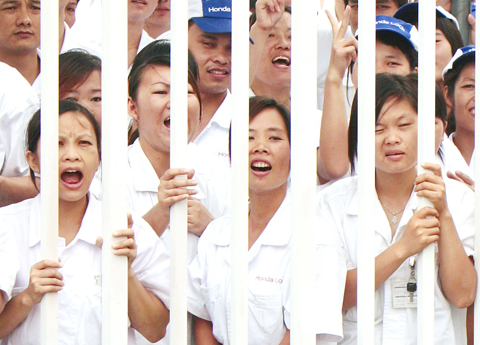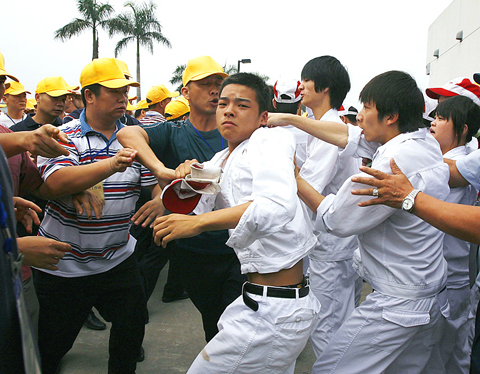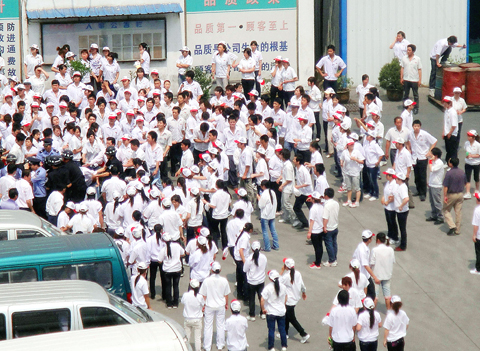|
¡@
An independent labor movement stirs in
China
As well as increasing in number, striking workers are becoming better
organized
By Keith Bradsher
NY TIMES NEWS SERVICE , ZHONGSHAN, CHINA
Sunday, Jun 13, 2010, Page 13

Striking workers stand behind a fence at Honda
Motor¡¦s vehicle manufacturing plant in Zhongshan, Guangdong Province, on
Thursday.
PHOTO: REUTERS
Striking workers at a Honda auto parts plant here are demanding the right to
form their own labor union, something officially forbidden in China, and held a
protest march Friday morning.
Meanwhile, other scattered strikes have begun to ripple into Chinese provinces
previously untouched by the labor unrest.
A near doubling of wages is the primary goal of the approximately 1,700 Honda
workers on strike here in this southeastern China city, at the third Honda auto
parts factory to face a work stoppage in the past two weeks.
A chanting but nonviolent crowd of workers gathered outside the factory gates
Friday morning and briefly started a protest march before dissolving into a
large group of milling young workers who filled the two-lane road for more than
a block outside the factory.
They were met by black-clad police with helmets, face masks and small round riot
shields. The police marched off at midmorning, leaving the workers to block the
road into the small industrial park next to a eucalyptus-lined muddy canal that
runs past the factory.
¡@

Striking workers confront a group of people
who claimed to be representatives of the workers¡¦ union at Foshan Fengfu
Autoparts Co¡¦s plant in Foshan, Guangdong Province, on May 31.
PHOTO: REUTERS
The workers dispersed about an hour after the police left and remained on
strike.
Management helped defuse the march by distributing a flier that essentially
offered about US$7.30 for each of the eight days that the factory was closed
beginning late last month as part of a nationwide shutdown of Honda
manufacturing set off by a transmission factory strike. Management previously
wanted to treat the strike as unpaid leave, workers said.
¡@

Some 2,000 workers stage a strike outside the
Taiwan-funded KOK Machinery rubber factory in Kunshan, Jiangsu Province, on
Monday.
PHOTO: AFP
This latest strike, which started Wednesday morning, has taken on political
dimensions.
The strikers here have developed a sophisticated, democratic organization, in
effect electing shop stewards to represent them in collective bargaining with
management. They are also demanding the right to form a trade union separate
from the government-controlled national federation of trade unions, which has
long focused on maintaining labor peace for foreign investors.
¡§The trade union is not representing our views; we want our own union that will
represent us,¡¨ said a striking worker, who insisted on anonymity for fear of
retaliation by government authorities or the company.
A Honda spokesman declined to comment on the details of the strike. The Chinese
government has been relatively lenient in allowing coverage of the labor unrest
because Honda is a Japanese company, and some anti-Japanese sentiment lingers in
China as a legacy of World War II.
Despite unusual forbearance in allowing the various strikes so far, the Chinese
government has shown no interest in tolerating unions with full legal
independence from the national union. And so far, government agencies at all
levels have shown little tolerance for marches and other unauthorized public
gatherings. It was unclear how they would react to the worker march on Friday
morning.
Dozens of workers gathered in clumps shortly before sunset on Thursday in front
of the sprawling parts factory and outspokenly criticized local authorities for
seeming to side with the company.
The workers said that large numbers of police officers had been positioned in
the factory on Wednesday and Thursday in an attempt to intimidate them. But they
said they would remain on strike. The two other Honda parts factories shut down
by walkouts in recent weeks have reopened after workers were promised large pay
increases.
Geoffrey Crothall, the spokesman for China Labour Bulletin, a labor advocacy
group based in Hong Kong that seeks independent labor unions and collective
bargaining in China, expressed surprise when told how the Honda workers here in
Zhongshan had organized themselves. ¡§It does reflect a new level of organization
and sophistication¡¨ in Chinese labor relations, he said.
The Chinese government has not allowed unions with full legal independence from
the national, state-controlled union. But the government has occasionally
finessed the issue by letting workers choose their factories¡¦ representatives of
the national union, or by allowing the creation of ¡§employee welfare committees¡¨
in parallel with the official local units, said Mary Gallagher, a China labor
specialist at the University of Michigan.
But these exceptions have tended to be in less prominent industries like shoe
manufacturing, and not in bastions of heavy industry like automaking.
Workers here were not specific Thursday about what would qualify as having their
own union. They are mostly in their early 20s, more than half are women. Their
education levels are low. Although several said they had high school degrees,
Honda requires only junior high school educations.
The workers say they want to be paid as much as workers at the first Honda
factory recently to go on strike, a high-tech transmission factory in Foshan
where the workers are almost entirely young men with a couple of years of
vocational school training in addition to high school degrees.
Besides the Honda strike here, there were reports on Thursday of strikes at
Japanese- and Taiwanese-owned factories in at least five other cities. Four of
the cities are outside the heavily industrial Guangdong Province, where all
three Honda auto parts strikes have taken place.
But the strikes involving the other employers appeared to have ended quickly as
managers, faced with an acute labor shortage, sought to address workers¡¦
demands. Honda has settled the strikes at its other two factories as well.
Chinese-owned companies tend not to disclose when strikes have occurred, and it
is not clear how many strikes over all have taken place in recent days.
The strike here stopped work at a two-story factory that makes rear and side
mirrors, door locks and a range of other auto parts for Honda assembly plants
over the world. The workers here say that employees in each department of the
factory held a meeting, discussed who would be their most persuasive
representative and then selected that person to represent them on a factory-wide
council that has held negotiations with management. Municipal officials and
representatives of the government-authorized labor union have also attended
meetings of the workers¡¦ council with management, workers said.
In a flier that workers said had been distributed to them by managers on
Thursday morning, the factory¡¦s management said it was beyond their authority to
recognize a union. The management said that a government labor board would
decide on the workers¡¦ request by June 19, and asked that the workers return to
their jobs in the meantime.
Dozens of workers from the factory gathered around a foreign reporter Thursday,
even though clean-cut men in crisp shirts, perhaps plainclothes police officers
or private security guards, were hovering nearby.
The workers, who insisted on anonymity because of lingering concerns about
retaliation, said that a company manager had announced over loudspeakers late
Thursday afternoon that all workers would be asked on Friday morning to sign a
new contract and would be dismissed if they failed to do so.
Asked if they would sign, the workers replied with a chorus of ¡§no!¡¨
Since going on strike on Wednesday morning, the workers have marched around
inside the factory each day shouting slogans like ¡§Increase our wages¡¨ before
going home each evening to cramped apartments in nearby buildings.
The workers voiced skepticism that the company would meet their demands, mainly
an 89 percent increase in their pay. It is currently US$132, for a 42-hour week.
An 89 percent increase would be a raise of about US$117. Many workers in
Guangdong Province already earn considerably more than the minimum wage because
of an acute labor shortage even before the strike started.
The minimum wage varies from city to city and changes frequently. It is
currently US$132 in Zhongshan, according to workers. Workers said that they had
read news reports on the Internet that Honda had already granted raises of US$73
in settling other strikes. Honda has not confirmed the raises, indicating only
that they were large in percentage terms.
Workers at the factory here said that their jobs required them to stand for
eight hours a day at their posts, and that pregnant women were allowed to sit
only in their last trimester. Workers also complained that they were not allowed
to speak while working ¡X a common requirement in Chinese factories ¡X and that
they had to obtain passes before going to the bathroom. They said they were
criticized if managers thought they took too long getting a drink of water.
A municipal official standing with a group of private security guards outside
the factory said that there was no evidence that Honda had broken any employment
laws. The workers ¡§just want more money, they¡¦re inspired by the other Honda
strikes,¡¨ said the official, who insisted on anonymity.
The strike began Wednesday morning after a woman employee showed up with her
identity card improperly attached to her shirt and was denied entry by a
security guard. The woman criticized the guard, who responded by shoving her to
the ground, the workers said.
Workers said that the factory¡¦s management had offered an increase of US$15 a
month in workers¡¦ allowance for food and housing. The allowance is currently or
US$44.
¡@
|
![]()
![]()
![]()